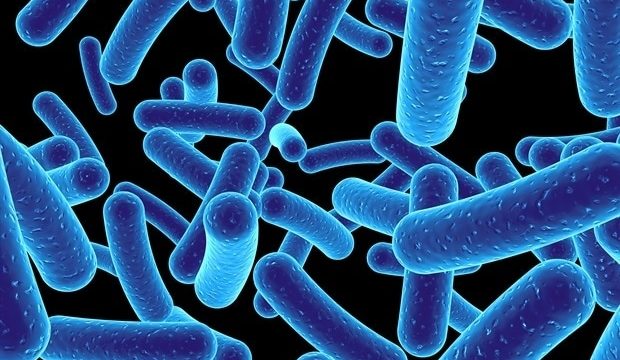Scientists have found that a predatory bacterium, capable of invading and consuming harmful bugs such as E.coli and Salmonella, can sculpt its own shape to fit inside its prey.
In a new paper, published in Nature Communications today, scientists from the Universities of Nottingham, Birmingham and Newcastle, showed that the curved (boomerang-like) shape of the bacterium, called Bdellovibrio bacteriovorus, is an important feature that affects its lifestyle, enabling it to efficiently invade, grow and live inside other bacteria.
The team also found that a bacterial cell-wall-modifying gene has unique features that enable the bacteria to sculpt its own distinctive shape.
The researchers previously discovered how the bacterium is able to invade prey cells, without harming themselves, by sculpting prey into a sphere shape using proteins that the Bdellovibrio secrete to change the prey's cell walls.
This spherical space inside the prey becomes a home in which the Bdellovibrio use the prey as food and grow and develop into cells shaped like a curved string of boomerang-shaped sausages. These separate, and then escape and find more prey.
Bdellovibrio bacteriovorus can be isolated from soil and water around the world and each isolate has the curved shape but its hasn't been fully understood why and how they are shaped like this. In this new paper, the researchers found that the curved boomerang shape of the Bdellovibrio, is produced by a special protein – Bd1075 – that the Bdellovibrio uses on itself (rather than secreting into prey). Without this protein the curved shape is lost.
Perturbation of this specialized shaping reduces the speed of prey invasion and changes how the Bdellovibrio fits inside the prey cells as they grow. Hence evolution of Bd1075 has allowed Bdellovibrio to shape itself to efficiently enter into and fit into the prey cell environment.
The study was led by Emma Banks and Professor Liz Sockett with Dr Carey Lambert, in the School of Life Sciences at the University of Nottingham. They worked with Mauricio Valdivia Delgado from Professor Andy Lovering's lab at the University of Birmingham.
Looking down the microscope and seeing that our color-tagged Bd1075 shape protein (marked in red on image 2) goes to just one side of the Bdellovibrio cell (the outer curve) was really cool. When I made certain changes to the Bd1075 protein, the protein then failed to go to the correct place. This helped to tell us how the protein localizes within curved Bdellovibrio cells."
Emma Banks, School of Life Sciences, University of Nottingham
Emma found that cells without the boomerang shape invade prey cells more slowly and also stretch round the prey cell by growing as straight filaments instead of curved. Evolution of Bd1075 has made these invasions and intracellular life processes more efficient and less likely to fail. Thus the Bdellovibrio are aided to successfully replicate inside other bacteria.
Professor Sockett explained "These experiments showed that the bacteria, which are only single cells, without nerves or brains, do have a kind of "molecular awareness" of their own shape ,and of the shape of the cell they invade and of the spherical prey cell environment that they grow inside. They use the Bd1075 protein in this process – this is quite an achievement for a single cell."
The team in Professor Lovering's lab at the University of Birmingham, then worked on understanding the structure of the Bd1075 protein.
Professor Lovering said: "We knew from our prior studies of other Bdellovibrio proteins that cell wall modifying enzymes could be diversified and used in unique ways that pertain to the predatory lifestyle.
"In those studies we looked at agents sent into the prey cell rather than those retained for use in self, but we were pleased to see that these principles of diversification were retained when analysing Bd1075. Once Mauricio had obtained the structure, we could see that relative to other shape-generating enzymes Bd1075 had several key changes, one of which changed the length and nature of the pocket used to direct its activity to the correct location in the cell.
"It is immensely satisfying to meld the structural and genetics-microscopy approaches together, and this was certainly the case here – trimming the modified Bd1075 pocket back to a length seen in those other systems completely prevented normal function and, as Emma saw by microscopy, that altered the distinctive curved cell shape."
Professor Sockett adds: "As a team, we always feel privileged to observe the beauty of evolution and the changes it bestows on Bdellovibrio bacteriovorus allowing it to be an efficient predatory invader of other bacteria. Learning about these mechanisms is important when thinking about how to design therapeutic invaders to combat pathogens in the future."
University of Nottingham
Banks, E.J., et al. (2022) Asymmetric peptidoglycan editing generates cell curvature in Bdellovibrio predatory bacteria. Nature Communications. doi.org/10.1038/s41467-022-29007-y.
Posted in: Microbiology | Histology & Microscopy
Tags: Bacteria, Cell, Cell Wall, Evolution, Food, Gene, Genetics, Intracellular, Microscope, Microscopy, Protein, Research, Salmonella
Source: Read Full Article
